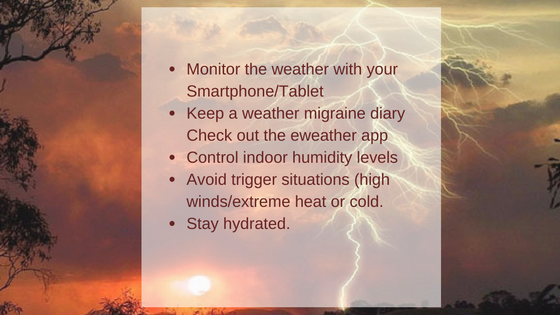For those, like me, who live in Florida, we are definitely experiencing some hurricane-related pressure changes. The weather reports show “freak” weather patterns all over the country and beyond at the moment.
Many us of are bombarded with rain, floods, tornadoes, high winds and high humidity. So, are you suffering more with migraines due to weather pattern changes?
If you suffer with weather-related migraines like I do, you know how hard it is to have control over anything like that. So, with that said, I wanted to give you something useful to help you through if you find yourself suffering from atmospheric/barometric changes that affect your migraines.
Did you know that one of the most common migraine triggers is the weather? Studies have shown that 75% of migraine sufferers have migraines that are triggered by changes in the atmospheric pressure. Of course, if you have migraines that you know are triggered by specific foods, then you it is much easier to control your “migraine life” by avoiding those triggers. But what can you do about headaches that are triggered by fluctuations in the barometric pressure?
What Is Barometric Pressure?
First of all, what is barometric pressure? It is a combination of that air and water pressure in the atmosphere which changes according to the prevailing weather conditions. Air pressure is the force exerted by the weight of air overhead → which is why high altitudes tend to have low air pressure. Water pressure actually refers to the same thing → which is why deep-sea divers can feel an increase in pressure when they dive deeper because of the weight of the water.
Nevertheless, neither low nor high pressure levels are the main challenge with migraine sufferers. Most people have pain triggered by the change in air pressure. You probably have already experienced that you can pretty much predict the weather according to how you feel. For example, some of you probably can sense the arrival of a storm. I know I can! So when Hurricane Matthew was churning around here last week, I noticed the pressure building up in my head for several days.
When meteorologist talk about fronts — like changes in barometric pressure — you may know that the low or falling pressure is association with deteriorating weather conditions or storms approaching. The air pressure can fall quickly and migraine suffers often detect this quick change. Rising barometric pressure usually indicates better weather, but most often with an increase in temperature and higher humidity levels…and unfortunately, high humidity is another common migraine trigger.
How Does Barometric Pressure Affect Migraine Sufferers?
There isn’t one definitive explanation as to why these types of headaches occur, but there have been several observations made that may help:
A change in electrical charges in the atmosphere (positive ionization, for example, which is linked to the release of serotonin)
A change in oxygen levels caused by low or high humidity. High humidity reduces oxygen levels, making it hard for us to receive the right amount of oxygen to function properly, and blood vessels expand or contract to compensate.
Pressure differences in air trapped in the inner ear or in blocked nasal cavities cause pain similar to sinus headaches
Migraine triggers and symptoms of migraine need to be tracked. This will help you to better manage them, and also give you insight into what your migraine triggers and symptoms are. To download you free migraine journal, ==>click here<==
How Do You Deal With Barometric Pressure Migraines?
Just knowing a migraine is on the way can help you ward off the symptoms by taking measure early in the cycle. This can include medication, or natural. Although it is harder to deal with weather-related migraines since they are harder to control, don’t lose hope. Here are some steps you can take.
Monitor the weather (you can use your Smartphone/tablet or just watch the weather reports
Keep a weather migraine diary. This will help you identify common weather-related patterns. Also, did you know there is such a thing as a migraine barometer that alerts you to falling or rising pressure once you know what your individual pattern is so that you can program it accordingly? (Check out the eweather app.)
Control indoor humidity levels. Dehumidifiers can help to regular humidity levels in the home.
If possible, avoid trigger situations like going out in high winds or extreme heat or cold.
Stay hydrated. Hot, humid weather can lead to heat exhaustion as well as dehydration, both of which can lead to migraines and headaches. Sip water at regular intervals, and remember that by the time you are thirsty, you are already dehydrated
It’s not always easy to be able to stop the beginning of a migraine with unpredictable weather patterns, but if you incorporate some of these strategies into your life, you may be able to minimize the effect the weather has on your migraines, and even prevent the triggering of a migraine with the barometric changes. As we know “forearmed is forewarned!” Definitely in these types of situations, being forearmed can work to our advantage.



I developed MCS in 1988. I always know when the barometric pressure was changing. My sinus would ache and frequently I would develop a headache. And of course no one believer me. Great to see what I knew validated.